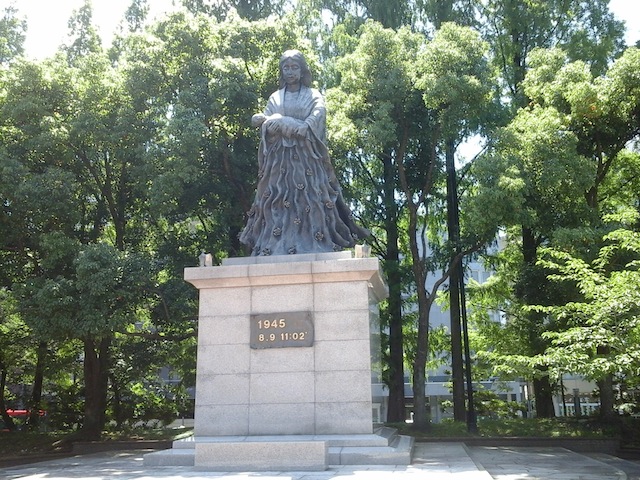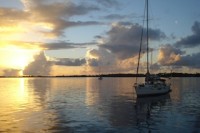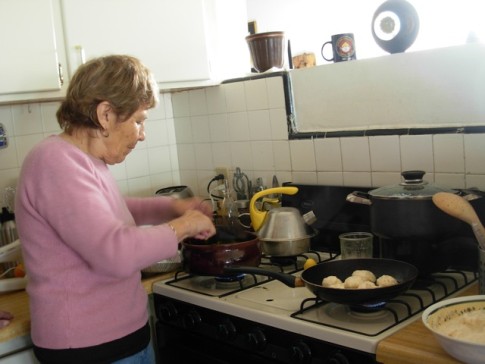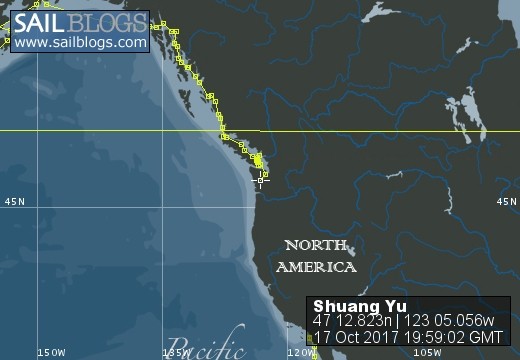
Joy of Cruising
17 October 2017 | Boat position at Shelton: 47°12.82’N; 123°05.01’W
16 October 2017 | Boat position at Shilshole Marina: 47°40.65’N; 122°24.59’W
15 October 2017 | Boat position at Friday Harbor: 48°32.20’N; 123°0.59’W
27 September 2017 | Boat position on Granville Island: 49°16.35’N; 123°08.24’W
26 September 2017 | Boat position on Granville Island: 49°16.35’N; 123°08.24’W
22 July 2017 | Boat position at Granville Island: 49°16.35’N; 123°08.24’W
21 July 2017 | Boat position at Vancouver Rowing Club, Canada: 49°17.77’N; 123°07.85’W
20 July 2017 | Boat position at the Vancouver Rowing Club, Canada: 49°17.77’N; 123°07.85’W
19 July 2017 | Boat position at the Vancouver Rowing Club: 49°17.77’N; 123°07.85’W
18 July 2017 | Boat position in Active Pass: 48°51.64’N; 123°18.54’W
17 July 2017 | Boat position at Otter Cove, Pender Island, Canada: 48°47.84’N; 123°18.51’W
15 July 2017 | Boat position at Port Bedwell, Pender Island, Canada: 48 44.97'N; 123 13.97'W
14 July 2017 | Boat position at RVYC: 48 27.19'N; 123 17.73'W
13 July 2017 | Boat position at RVYC: 48 27.19'N; 123 17.73'W
12 July 2017 | Boat position at SNSYC: 48 40.44'N; 123 25.02'W
12 July 2017 | Boat position at SNSYC: 48 40.44'N; 123 25.02'W
11 July 2017 | Boat position at SNSYC: 48 40.44'N; 123 25.02'W
10 July 2017 | Boat position at Ganges: 48 51.00'N; 123 29.53'W
09 July 2017 | Boat position at Ganges: 48 51.00'N; 123 29.53'W
08 July 2017 | Boat position at Montague Harbour: 48 53.63'N; 123 24.03'W
Nagasaki
06 July 2015 | Boat position at Sunset Marina, Fukuda, Japan: 32 44.35'N; 129 48.94'E.
Pam Lau

Picture: The Peace Memorial Park in Nagasaki where the atomic bomb was dropped on August 9, 1945 at 11:02 a.m.
The bus to Nagasaki, from the marina at Fukuda, can be caught at two different locations; outside the marina or in Fukuda town, 10 minutes walk away. In town there are bus stops all along the main highway. The 30-minute ride to Nagasaki winds through mountain roads lined with houses clinging precariously to steep slopes. I have to confess that we did not see much of Nagasaki because we spent a lot of time working on the boat and/or preparing for typhoons. We did, however, visit the places that unfortunately made Nagasaki famous; the Atomic Bomb sights.
To get to ground zero at Urakami, northern Nagaski, we took a bus to the city station and then hopped on a tram. These old trams, which are still in everyday use, reminded me of the San Francisco cable trams. The fares are reasonable and they run frequently. At Urakami we bought some coffee at a convenience store and sat down to drink it under the shade of some big trees at the Atomic Bomb Hypocentre Park. It is a quiet park except for the occasional tour group passing by. There is a smooth black stone column marking the point on the ground where the bomb exploded 500 meters overhead. Nearby is a section of the wall of the Urakami (Catholic) Cathedral. The church, constructed of stone, concrete and brick, with many ornate stained glass windows, was a short distance from where the bomb exploded. Miraculously one small section of wall was still standing so they moved it to the park as a memorial.
A short distance from the Atomic Bomb Hypocentre Park is the Nagasaki Atomic Bomb Museum. I remember learning about the atomic bombs dropped on Japan in high school history classes, but it was merely facts and figures like any other subject. However, being in the museum and seeing all the evidence of the death and destruction through photos, artifacts, furniture, rocks, trees and other objects, the tragic events became real and more meaningful. There were large panels that recount the pre-bombing events, which I thought was powerful. The Allied Atomic Bomb Committee met three times to select the target cities in Japan. On August 6, the first atomic bomb was dropped on Hiroshima. On August 8, field order #17 from the 20th U.S. Air Force headquarter at Guam ordered that the bomb, nicknamed “fat boy” be loaded on the plane and dropped on Kokura, the primary target, or Nagasaki, the secondary target. It was called “fat boy” because it was much larger and more powerful than the Hiroshima bomb. The B-29 bomber nicknamed, “Bockscar”, reached the sky over Kokura on the morning of August 9th, 1945, but the visibility was poor because of smoke, so the plane continued on to Nagasaki. The visibility there was also poor because of cloudy conditions and the bomber captain was considering whether to abandon the mission when there was a break in the clouds and the large Mitsubishi munitions factories and ship yards became visible. “Fat Boy” was released over the suburb of Urakami. Several timepieces, all stopped at exactly 11:02, were found amongst the debris. A wartime map of the city showed that many of the buildings destroyed were schools, hospitals, a prisoner-of-war (POW) camp and the Urakami Cathedral which was the largest in Asia. It took three decades to build and three seconds to demolish. The museum had video monitors showing testimonials from the A-bomb victims in the form of interviews by residents and foreigners, including Australian POW’s and Korean forced laborers. Some of the stories shared by victims contained vivid images of the day when the world seemed to come to an end for them. One woman was six years old and witnessed people changed to “charcoal” with their hair standing up like wire; other people had flesh falling from their bodies as they cried out in agony. Can you image how a small child would feel at the time? A doctor in one of the hospitals shared his story about feeling helpless to be the only doctor available to help thousands of severely wounded people. People started arriving at the hospital soon after the blast but the building was later destroyed by the fires that followed. We were at the museum for a long time listening to the horrifying stories. Towards the end of the exhibits, there was a chilling display illustrating the nations still holding nuclear weapons; Russia holds the most, followed closely by the USA.
Several hours later we emerged from the museum totally drained, emotionally. The blast of hot air on a swelteringly hot day added to our fatigue so we did not go up to the Heiwa-koen (Peace Park) where stands the 10-tonne bronze Nagasaki Peace Statue and a fountain dedicated to world peace. Nor did we visit the Nagasaki National Peace Memorial Hall for the Atomic Bomb Victims. We simply ran out of energy. I bought two steamed barbecue pork buns at a 7-11 store and sat on a park bench under some shade trees across from the new Urakami Cathedral. We had an excellent view of this handsome building, built exactly the same as the original. After food and drink, we climbed up the hill to the church and said some prayers for the victims, dead and alive, and to pray for world peace.
The bus to Nagasaki, from the marina at Fukuda, can be caught at two different locations; outside the marina or in Fukuda town, 10 minutes walk away. In town there are bus stops all along the main highway. The 30-minute ride to Nagasaki winds through mountain roads lined with houses clinging precariously to steep slopes. I have to confess that we did not see much of Nagasaki because we spent a lot of time working on the boat and/or preparing for typhoons. We did, however, visit the places that unfortunately made Nagasaki famous; the Atomic Bomb sights.
To get to ground zero at Urakami, northern Nagaski, we took a bus to the city station and then hopped on a tram. These old trams, which are still in everyday use, reminded me of the San Francisco cable trams. The fares are reasonable and they run frequently. At Urakami we bought some coffee at a convenience store and sat down to drink it under the shade of some big trees at the Atomic Bomb Hypocentre Park. It is a quiet park except for the occasional tour group passing by. There is a smooth black stone column marking the point on the ground where the bomb exploded 500 meters overhead. Nearby is a section of the wall of the Urakami (Catholic) Cathedral. The church, constructed of stone, concrete and brick, with many ornate stained glass windows, was a short distance from where the bomb exploded. Miraculously one small section of wall was still standing so they moved it to the park as a memorial.
A short distance from the Atomic Bomb Hypocentre Park is the Nagasaki Atomic Bomb Museum. I remember learning about the atomic bombs dropped on Japan in high school history classes, but it was merely facts and figures like any other subject. However, being in the museum and seeing all the evidence of the death and destruction through photos, artifacts, furniture, rocks, trees and other objects, the tragic events became real and more meaningful. There were large panels that recount the pre-bombing events, which I thought was powerful. The Allied Atomic Bomb Committee met three times to select the target cities in Japan. On August 6, the first atomic bomb was dropped on Hiroshima. On August 8, field order #17 from the 20th U.S. Air Force headquarter at Guam ordered that the bomb, nicknamed “fat boy” be loaded on the plane and dropped on Kokura, the primary target, or Nagasaki, the secondary target. It was called “fat boy” because it was much larger and more powerful than the Hiroshima bomb. The B-29 bomber nicknamed, “Bockscar”, reached the sky over Kokura on the morning of August 9th, 1945, but the visibility was poor because of smoke, so the plane continued on to Nagasaki. The visibility there was also poor because of cloudy conditions and the bomber captain was considering whether to abandon the mission when there was a break in the clouds and the large Mitsubishi munitions factories and ship yards became visible. “Fat Boy” was released over the suburb of Urakami. Several timepieces, all stopped at exactly 11:02, were found amongst the debris. A wartime map of the city showed that many of the buildings destroyed were schools, hospitals, a prisoner-of-war (POW) camp and the Urakami Cathedral which was the largest in Asia. It took three decades to build and three seconds to demolish. The museum had video monitors showing testimonials from the A-bomb victims in the form of interviews by residents and foreigners, including Australian POW’s and Korean forced laborers. Some of the stories shared by victims contained vivid images of the day when the world seemed to come to an end for them. One woman was six years old and witnessed people changed to “charcoal” with their hair standing up like wire; other people had flesh falling from their bodies as they cried out in agony. Can you image how a small child would feel at the time? A doctor in one of the hospitals shared his story about feeling helpless to be the only doctor available to help thousands of severely wounded people. People started arriving at the hospital soon after the blast but the building was later destroyed by the fires that followed. We were at the museum for a long time listening to the horrifying stories. Towards the end of the exhibits, there was a chilling display illustrating the nations still holding nuclear weapons; Russia holds the most, followed closely by the USA.
Several hours later we emerged from the museum totally drained, emotionally. The blast of hot air on a swelteringly hot day added to our fatigue so we did not go up to the Heiwa-koen (Peace Park) where stands the 10-tonne bronze Nagasaki Peace Statue and a fountain dedicated to world peace. Nor did we visit the Nagasaki National Peace Memorial Hall for the Atomic Bomb Victims. We simply ran out of energy. I bought two steamed barbecue pork buns at a 7-11 store and sat on a park bench under some shade trees across from the new Urakami Cathedral. We had an excellent view of this handsome building, built exactly the same as the original. After food and drink, we climbed up the hill to the church and said some prayers for the victims, dead and alive, and to pray for world peace.
Comments
| Vessel Name: | Shuang Yu |
| Vessel Make/Model: | Catalina 400 |
| Hailing Port: | San Diego |
| Crew: | Ted Berry and Pam Lau |
| Home Page: | www.sailblogs.com/member/tedandpam/ |
| Social: |

Who: Ted Berry and Pam Lau
Port: San Diego



